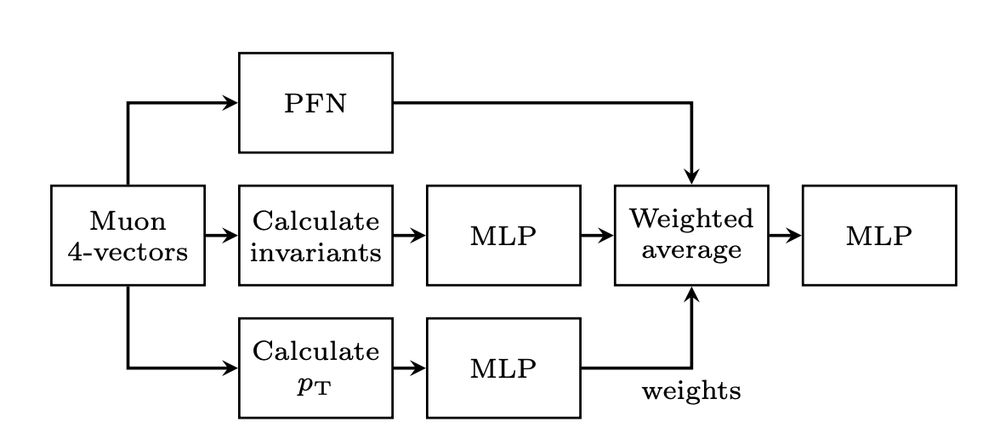Congratulations Erik for this #EPiC [1] PhD!
[1] arxiv.org/abs/2301.08128

Congratulations Erik for this #EPiC [1] PhD!
[1] arxiv.org/abs/2301.08128
He did a great job, not only on the CATHODE approach for anomaly detection based on weak supervision, but also applying it to data collected by the CMS experiment at CERN.
#PhDone

He did a great job, not only on the CATHODE approach for anomaly detection based on weak supervision, but also applying it to data collected by the CMS experiment at CERN.
#PhDone
Great work by Seth with @aishikghosh.bsky.social, Ed, @danielwhiteson.bsky.social
Full paper: arxiv.org/abs/2412.18773


Great work by Seth with @aishikghosh.bsky.social, Ed, @danielwhiteson.bsky.social
Full paper: arxiv.org/abs/2412.18773
Check out arxiv.org/abs/2411.00085 for a new idea on how to extract anomalies!

Check out arxiv.org/abs/2411.00085 for a new idea on how to extract anomalies!
🤔 Foundation models need huge amounts of training data.
🤔 There now exist large volumes of #OpenData by e.g. @cmsexperiment.bsky.social
💡 Why not use that data for training?

🤔 Foundation models need huge amounts of training data.
🤔 There now exist large volumes of #OpenData by e.g. @cmsexperiment.bsky.social
💡 Why not use that data for training?
Besides great talks by Hamburg & other students, we also got to see the local KATRIN experiment which is trying to measure the neutrino mass

Besides great talks by Hamburg & other students, we also got to see the local KATRIN experiment which is trying to measure the neutrino mass
This was a *truly* interdisciplinary work [1] between particle physics, maths/statistics (thanks to excellent co-supervisor Mathias Trabs) and machine learning!
[1] inspirehep.net/authors/1906...

This was a *truly* interdisciplinary work [1] between particle physics, maths/statistics (thanks to excellent co-supervisor Mathias Trabs) and machine learning!
[1] inspirehep.net/authors/1906...
No new physics but it shows that ML-based anomaly detection methods can indeed be applied to collider data and offer a broad sensitivity to different potential signals!

No new physics but it shows that ML-based anomaly detection methods can indeed be applied to collider data and offer a broad sensitivity to different potential signals!
Concepts from physics have been pivotal in developing machine learning & in turn we can use modern AI tools to do amazing physics.
Video here (in German): www.tagesschau.de/multimedia/v...

Concepts from physics have been pivotal in developing machine learning & in turn we can use modern AI tools to do amazing physics.
Video here (in German): www.tagesschau.de/multimedia/v...
indico.desy.de/event/42884/...

indico.desy.de/event/42884/...
Don't usually post too many photos, but this might be a justified exception
Program & slides at: indico.cern.ch/event/1299889/
With many thanks to the organisers Kevin, Mayda, and Michael!



Don't usually post too many photos, but this might be a justified exception
Program & slides at: indico.cern.ch/event/1299889/
With many thanks to the organisers Kevin, Mayda, and Michael!
In case you want to know more, @cmsexperiment.bsky.social has you covered: cms.cern/news/searchi...
#PhDdone

In case you want to know more, @cmsexperiment.bsky.social has you covered: cms.cern/news/searchi...
#PhDdone

In arxiv.org/abs/2312.00123 we show how to scale generative models to more complex data, and learn many properties (1st pic) beyond kinematics for 10 types of jets (2nd pic) based on the JetClass dataset
Code to compare, etc soon at: github.com/uhh-pd-ml/be...


In arxiv.org/abs/2312.00123 we show how to scale generative models to more complex data, and learn many properties (1st pic) beyond kinematics for 10 types of jets (2nd pic) based on the JetClass dataset
Code to compare, etc soon at: github.com/uhh-pd-ml/be...
indico.in2p3.fr/event/30589/...

indico.in2p3.fr/event/30589/...
Full program and slides for all talks at: indico.in2p3.fr/event/30589/...
Thanks to DavidR #AISSAI et al for great organisation

Full program and slides for all talks at: indico.in2p3.fr/event/30589/...
Thanks to DavidR #AISSAI et al for great organisation
Caught in discussion with our excellent spokesperson Erika
(Luckily the top-secret sheet of paper is sufficiently blurry)

Caught in discussion with our excellent spokesperson Erika
(Luckily the top-secret sheet of paper is sufficiently blurry)
Look no further than our note out now! cds.cern.ch/record/28810...
While no results on data (yet), it gives a shape of the things to come...

Look no further than our note out now! cds.cern.ch/record/28810...
While no results on data (yet), it gives a shape of the things to come...
Thanks for all the seriously excellent developments on AI applied to particle physics (& beyond)
Not going to summarize the 133 (!) contributions here, but you can check out the slides: indico.cern.ch/event/1253794

Thanks for all the seriously excellent developments on AI applied to particle physics (& beyond)
Not going to summarize the 133 (!) contributions here, but you can check out the slides: indico.cern.ch/event/1253794
If you'd like to join our workshop on 'Fundamental Physics in the Era of Big Data and Machine Learning' you know where to go..
[1] aspenphys.org/physicists/s...

If you'd like to join our workshop on 'Fundamental Physics in the Era of Big Data and Machine Learning' you know where to go..
[1] aspenphys.org/physicists/s...

A nice side effect of recent better generative models for HEP data is that we can now learn and interpolate in much higher dimensions, improving anomaly detection


A nice side effect of recent better generative models for HEP data is that we can now learn and interpolate in much higher dimensions, improving anomaly detection




